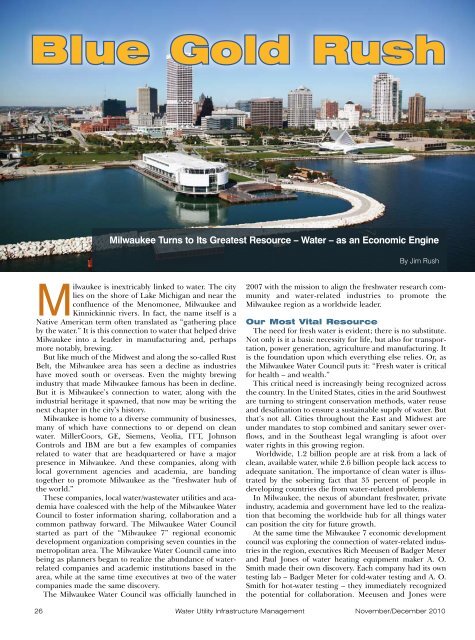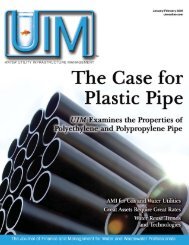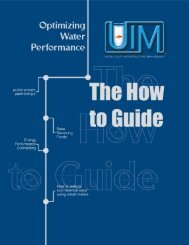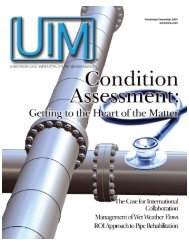Download - Water Utility Infrastructure Management
Download - Water Utility Infrastructure Management
Download - Water Utility Infrastructure Management
You also want an ePaper? Increase the reach of your titles
YUMPU automatically turns print PDFs into web optimized ePapers that Google loves.
Blue Gold RushMilwaukee Turns to Its Greatest Resource – <strong>Water</strong> – as an Economic EngineBy Jim RushMilwaukee is inextricably linked to water. The citylies on the shore of Lake Michigan and near theconfluence of the Menomonee, Milwaukee andKinnickinnic rivers. In fact, the name itself is aNative American term often translated as “gathering placeby the water.” It is this connection to water that helped driveMilwaukee into a leader in manufacturing and, perhapsmore notably, brewing.But like much of the Midwest and along the so-called RustBelt, the Milwaukee area has seen a decline as industrieshave moved south or overseas. Even the mighty brewingindustry that made Milwaukee famous has been in decline.But it is Milwaukee’s connection to water, along with theindustrial heritage it spawned, that now may be writing thenext chapter in the city’s history.Milwaukee is home to a diverse community of businesses,many of which have connections to or depend on cleanwater. MillerCoors, GE, Siemens, Veolia, ITT, JohnsonControls and IBM are but a few examples of companiesrelated to water that are headquartered or have a majorpresence in Milwaukee. And these companies, along withlocal government agencies and academia, are bandingtogether to promote Milwaukee as the “freshwater hub ofthe world.”These companies, local water/wastewater utilities and academiahave coalesced with the help of the Milwaukee <strong>Water</strong>Council to foster information sharing, collaboration and acommon pathway forward. The Milwaukee <strong>Water</strong> Councilstarted as part of the “Milwaukee 7” regional economicdevelopment organization comprising seven counties in themetropolitan area. The Milwaukee <strong>Water</strong> Council came intobeing as planners began to realize the abundance of waterrelatedcompanies and academic institutions based in thearea, while at the same time executives at two of the watercompanies made the same discovery.The Milwaukee <strong>Water</strong> Council was officially launched in2007 with the mission to align the freshwater research communityand water-related industries to promote theMilwaukee region as a worldwide leader.Our Most Vital ResourceThe need for fresh water is evident; there is no substitute.Not only is it a basic necessity for life, but also for transportation,power generation, agriculture and manufacturing. Itis the foundation upon which everything else relies. Or, asthe Milwaukee <strong>Water</strong> Council puts it: “Fresh water is criticalfor health – and wealth.”This critical need is increasingly being recognized acrossthe country. In the United States, cities in the arid Southwestare turning to stringent conservation methods, water reuseand desalination to ensure a sustainable supply of water. Butthat’s not all. Cities throughout the East and Midwest areunder mandates to stop combined and sanitary sewer overflows,and in the Southeast legal wrangling is afoot overwater rights in this growing region.Worldwide, 1.2 billion people are at risk from a lack ofclean, available water, while 2.6 billion people lack access toadequate sanitation. The importance of clean water is illustratedby the sobering fact that 35 percent of people indeveloping countries die from water-related problems.In Milwaukee, the nexus of abundant freshwater, privateindustry, academia and government have led to the realizationthat becoming the worldwide hub for all things watercan position the city for future growth.At the same time the Milwaukee 7 economic developmentcouncil was exploring the connection of water-related industriesin the region, executives Rich Meeusen of Badger Meterand Paul Jones of water heating equipment maker A. O.Smith made their own discovery. Each company had its owntesting lab – Badger Meter for cold-water testing and A. O.Smith for hot-water testing – they immediately recognizedthe potential for collaboration. Meeusen and Jones were26 <strong>Water</strong> <strong>Utility</strong> <strong>Infrastructure</strong> <strong>Management</strong>November/December 2010








